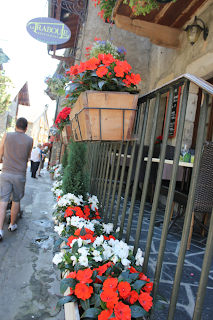 Around the beginning of the 1800's, over 100,00 people packed themselves into a 3 square mile in the center of Edinburgh along the Royal Mile. Most of this population lived in 7 to 12 story buildings called "closes" which lined the Royal Mile. In these closes would live the impoverished community, packed 10-12 people in a 15x10 foot room, battling diseases, robbers, poverty and the plague. Mary King was a prominent member of Edinburgh society and therefor had her own close. Around the turn of the 20th century, Edinburgh decided to build afresh their city so they paved a concrete street over the first 2-3 stories of the closes along the mile in order to kick out some of these impoverished folks living there and give there town a fresh look. Today you can pay some money and take a tour of Mary King's close. The guide takes you down under ground to the exquisitely preserved close. The buildings, tunnels and caverns all are still intact and one can get a true sense of what it was like to live there. This close in particular housed plague victims and was the scene of several gruesome murders and kidnappings. Many different paranormal groups claim that it is haunted because of its vile history. The tour guide will even shut the lights off and tell you some ghost stories and paranormal experiences many people have had in the close. I found this experience fascinating. But there is even more to the mile.
Around the beginning of the 1800's, over 100,00 people packed themselves into a 3 square mile in the center of Edinburgh along the Royal Mile. Most of this population lived in 7 to 12 story buildings called "closes" which lined the Royal Mile. In these closes would live the impoverished community, packed 10-12 people in a 15x10 foot room, battling diseases, robbers, poverty and the plague. Mary King was a prominent member of Edinburgh society and therefor had her own close. Around the turn of the 20th century, Edinburgh decided to build afresh their city so they paved a concrete street over the first 2-3 stories of the closes along the mile in order to kick out some of these impoverished folks living there and give there town a fresh look. Today you can pay some money and take a tour of Mary King's close. The guide takes you down under ground to the exquisitely preserved close. The buildings, tunnels and caverns all are still intact and one can get a true sense of what it was like to live there. This close in particular housed plague victims and was the scene of several gruesome murders and kidnappings. Many different paranormal groups claim that it is haunted because of its vile history. The tour guide will even shut the lights off and tell you some ghost stories and paranormal experiences many people have had in the close. I found this experience fascinating. But there is even more to the mile.Next, we discovered the 500 year old St. Giles Cathedral. It is an iconic Edinburgh landmark with its crown shaped roof and high Gothic architecture. While there, the local choir was practicing for the weekend's mass. It was an enlightening experience to sit in the pews and admire the stain class and architecture while listening to beautiful hymns sung by the choir.
 Continuing up the mile, we were able to explore some more shops and pubs. The pub culture, like most of the UK, is front and center in Scottish culture. They truly pride themselves on their delicately aged Scotch Whiskey and different home brewed beers and are always eager to help tourist try some select vintages.
Continuing up the mile, we were able to explore some more shops and pubs. The pub culture, like most of the UK, is front and center in Scottish culture. They truly pride themselves on their delicately aged Scotch Whiskey and different home brewed beers and are always eager to help tourist try some select vintages.Our adventure up the mile was capped off by several street performances including the musical stylings of a group of bagpipers. Yeah I know its
touristy but its something you need to experience
while discovering Edinburgh.
The Royal Mile is steeped in history, centuries old architecture, entertaining street performers, and the occasional paranormal experience. When traveling to Edinburgh, the Royal Mile is a must experience and in the end, it will lead you to Edinburgh Castle which is an experience in and of itself. Cheers.





